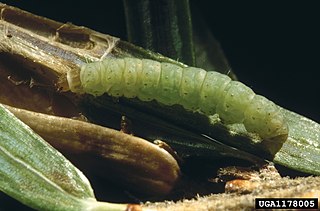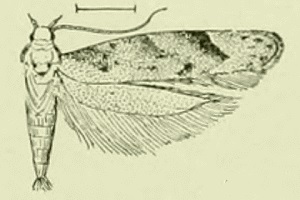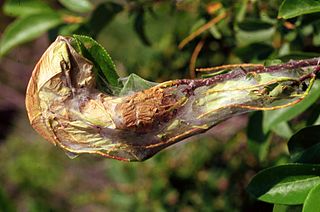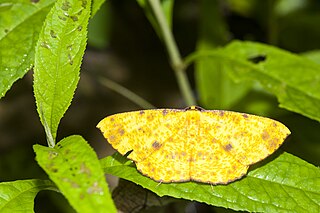
The northern parula is a small New World warbler. It breeds in eastern North America from southern Canada to Florida.

The rock vole, also known as the yellow-nosed vole, is a medium-sized species of vole found in eastern North America.

Thymelicus lineola, known in Europe as the Essex skipper and in North America as the European skipper, is a species of butterfly in the family Hesperiidae.

The forest tent caterpillar moth is a moth found throughout North America, especially in the eastern regions. Unlike related tent caterpillar species, the larvae of forest tent caterpillars do not make tents, but rather, weave a silky sheet where they lie together during molting. They also lay down strands of silk as they move over branches and travel as groups along these pheromone-containing silk trails. The caterpillars are social, traveling together to feed and massing as a group at rest. Group behavior diminishes as the caterpillars increase in size, so that by the fifth instar (molt) the caterpillars are feeding and resting independently.

Halysidota tessellaris, also called the pale tiger moth, banded tussock moth, and tessellated halisidota, is in the family Erebidae and the tribe Arctiini, the tiger moths. The species was first described by James Edward Smith in 1797. Like many related species, adult moths have chemical defenses acquired from its host plants, in this case, alkaloids. Larval behaviors suggest that they are chemically protected; they have not been analyzed for alkaloid content.

The black arches or nun moth is a small Palaearctic moth. It is considered a forest pest.
Textile manufacturing is one of the oldest human activities. The oldest known textiles date back to about 5000 B.C. In order to make textiles, the first requirement is a source of fibre from which a yarn can be made, primarily by spinning. The yarn is processed by knitting or weaving to create cloth. The machine used for weaving is the loom. Cloth is finished by what are described as wet process to become fabric. The fabric may be dyed, printed or decorated by embroidering with coloured yarns.

The green hemlock needleminer, hemlock leaf miner or baldcypress webworm is a moth of the family Gelechiidae. It is found in the eastern parts of the United States, as well as eastern Canada.
Coleotechnites ponderosae, the ponderosa pine needleminer, is a moth of the family Gelechiidae. It is found in the United States, where it has been recorded from Colorado.

Coleotechnites piceaella is a moth of the family Gelechiidae. It is found in north-eastern United States and Canada. It is an introduced species in Europe and was first recorded from Great Britain in 1952, then Germany in 1963 and has expanded from there over all of central Europe, towards France, Italy and Hungary.

Bactra venosana, the nutgrass borer or nutsedge borer, is a moth of the family Tortricidae. It was first described by Philipp Christoph Zeller in 1847. Julius von Kennel provides a full description. It has a wide distribution, from southern Europe, North Africa and Asia Minor to India, Sri Lanka, southern China, Malaya, Australia and into the Pacific where it is found on Java, Borneo, the Philippines, Taiwan, Timor, the Solomons, the Carolines and Fiji. It was introduced to Hawaii in 1925 to control nutsedge. It is now found on Kauai, Oahu, Molokai, Maui, Lanai and Hawaii.

Archips cerasivorana, the ugly-nest caterpillar moth, is a species of moth of the family Tortricidae. The caterpillars of this species are known to create nests by tying the leaves of their host plant together. Within the nests, they live and feed off the leaves that have been tied together. The larvae are brownish or greenish yellow with a shiny dark brown head. Larvae can be found from May to July. The species overwinters as an egg, and pupation takes place within the nest. Caterpillars are seen to follow one another in trails, a behavior prompted by the release of signaling pheromones from their spinnerets.

Coleotechnites blastovora is a moth of the family Gelechiidae. It is found in North America, where it has been recorded from Quebec, Alberta, British Columbia, New Brunswick and Saskatchewan.
Coleotechnites canusella, the banded jack-pine needleminer moth, is a moth of the family Gelechiidae. It is found in North America, where it has been recorded from British Columbia, Washington, Alabama, Arizona, Louisiana, New Mexico and South Carolina.
Coleotechnites chillcotti is a moth of the family Gelechiidae. It is found in North America, where it has been recorded from Alabama, Louisiana, Maryland, New Jersey, Pennsylvania and South Carolina.
Coleotechnites coniferella is a moth of the family Gelechiidae. It is found in North America, where it has been recorded from California, Illinois, Indiana, Maryland, Massachusetts, Michigan, Minnesota, Mississippi, New York, Ontario, Washington and Wisconsin.
Coleotechnites ducharmei is a moth of the family Gelechiidae. It is found in North America, where it has been recorded in south-western Nova Scotia, southern Quebec, Ontario, and Alberta.
Coleotechnites resinosae, the red pine needleminer moth, is a moth of the family Gelechiidae. It is found in North America, where it has been recorded from Ontario, Alabama and New Hampshire.

Coleotechnites starki, the northern lodgepole needle miner, is a moth of the family Gelechiidae. It is found in North America, where it has been recorded from Alberta, Arizona, British Columbia, Montana and Florida.

Eumelea ludovicata is a species of moth in the family Geometridae first described by Achille Guenée in 1858. It is found in Indo-Australian tropics of India, Sri Lanka, east to Singapore, Taiwan, the Solomon Islands and Guam.













